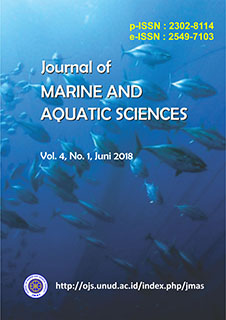Diatom Epipelik sebagai Bioindikator Pencemaran di Estuari Suwung
Abstract
Epiphelic diatoms are the living diatoms adhere to the bottom substrate of the waters. Epiphelic diatoms ware used as bioindicators because sensivity of enviromental change, widely distributed, and ware not affected by currents. Epiphelic diatom research as a bioindicator of pollution in the Suwung estuary was conducted in December 2016 and January 2017. The sampling of epiphelic diatom using the method of "Lens tissue trapping method". The results of research in December 2016 found 34 species of epiphelic diatoms, while in January 2017 found 24 species of epiphelic diatom. Species that are often found in this study are Pleurosigma clavei, Rhabdonema arcuatum, Synedra gailloni and Gomphonema angustatum. The highst of epipelic diatom abundance in estuari suwung in January 2017 was 8.82 Ind/and the lowest epiphelic diatom abundance of 0.41 Ind/. The assessment of contamination using epiphelic diatom using two methods such as diversity index and saprobik index. The pollution assessment based on the diversity index shows that in December 2016 it was varied, not contaminated, mildly polluted, moderately polluted while the saprobic index-based valuation was varied ie clean, moderately polluted and heavily polluted. Assessment of pollution with saprobik index is used to know the contamination of organic matter. Diversity index in January 2017 and the saprobic index had the same pattern that almost of station research in Suwung estuary research stations were moderately polluted and there was an increase in pollution
Downloads

This work is licensed under a Creative Commons Attribution 3.0 International License.
Copyright 2012 - 2023 Journal of Marine and Aquatic Sciences (JMAS)
Published by Fakultas Kelautan dan Perikanan Universitas Udayana, Denpasar, Bali, Indonesia
JMAS (p-ISSN 2302-8114; e-ISSN 2549-7103)


